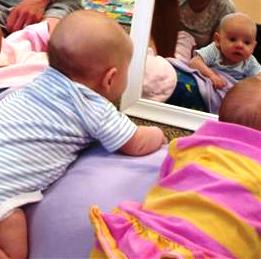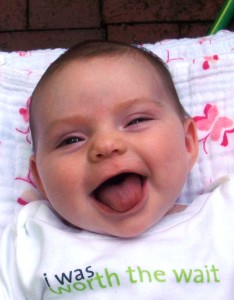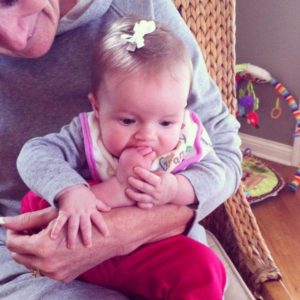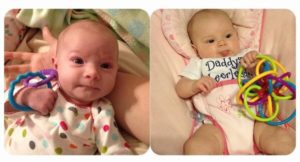Gross Motor Play for Babies about 5 to 8 months old
Once your baby is enjoying more “Floor Time” and finding new ways to move his body, incorporating new “gross motor” activities will create fun new ways to challenge his skills.
Always keep safety in mind: stay nearby (or provide hands-on “spotting” if needed), make sure all toys and materials are child-safe and choke-hazard-free, and provide an appropriate surface for the expected occasional tumbles such as carpet or foam-flooring.
Try any of these ideas from about six months onward.
Tunnel Play: a collapsing tunnel is a fantastic play environment that offers many different uses over the coming months and years. Before your baby is crawling, try placing a sheet folded into a long strip all the way through the tunnel. Then, give your baby a “ride”, pulling him slowly through the tunnel, first on his back, and next on his tummy. Once your baby is crawling, he’ll crawl through the tunnel with your smiling face encouraging him at the other end. Later still, he’ll crawl after a ball or pull toy you roll through the tunnel. And after that, a tunnel can become part of a more complex “obstacle course” set up for your toddler. Best still, when not in use, your tunnel collapses flat and can be tucked in a closet or under a bed.
Rody and Gym Ball play: With your hands-on assistance, your baby will enjoy practicing bouncing on these objects, and tilting from side to side. Slide your hands down to your baby’s hips (rather than holding him under the armpits) to allow his own trunk muscles to work on balance. If you are using a gym ball, you can sit him on top for some activities, and lay him tummy down on the ball for others. Facing a full-length mirror is fantastic when possible.
Bouncing on parent’s lap with songs and rhymes. Your baby is ready for exciting “rides” with bigger rises and (controlled) falls and swoops! Three favorite active bounces to try:
Trot-Trot to Boston
Trot-trot to Boston, Trot-trot to Lynn. Look out little Baby, that you don’t FALL IN!
Bounce baby on your lap and while holding securely, allow your baby to either tilt back or drop through your legs at the end.
Noble Duke of York
Oh, the Noble Duke of York, he had ten thousand men.
He rode them UP to the top of the hill, and he rode them DOWN again!
And when you’re UP, You’re UP. And when you’re DOWN, you’re DOWN.
And when you’re only HALFWAY UP, you’re neither UP nor DOWN!
Sit baby straddled across your leg like a horse and bounce baby rhythmically, raising and lowering baby to the up and down cues of the song. This is a truly a favorite!
Pop! Goes the Weasel
All around the cobbler’s bench, the monkey chased the weasel.
The monkey thought it was all in fun, then… POP! Goes the weasel!
Bounce baby on your lap to the rhthm of the song and while holding securely, do a big lift up at the “POP!”
You may find it a little tiresome singing the same songs over and over, but your baby thrives on the repetition, and begins to anticipate the movements and exciting finish! This familiarity helps him be an active participant in the activity.
Baby Ball Pit
Take one package of Ball Pit Balls and dump the balls into your pop-up travel crib/play-yard. Presto! Easy ball pit!
This is an easy activity and can provide many hours of play when used selectively. The balls are easy to put away and bring out on special occasions when you need a diversion. Meanwhile several balls at a time can be used for other activities such as dropping in and out of a bucket, rolling down a makeshift ramp, playing “catch” by rolling back and forth with caregiver while sitting on the floor, and as your child grows, for “indoor bowling” or counting and sorting by color.



